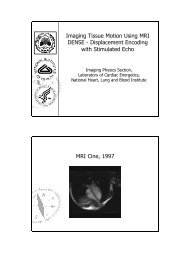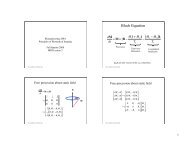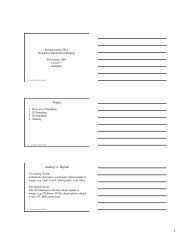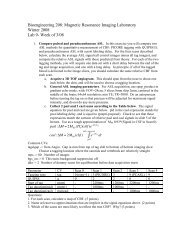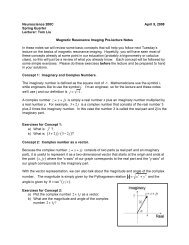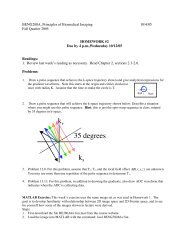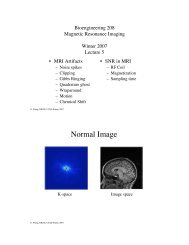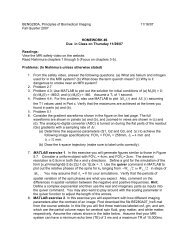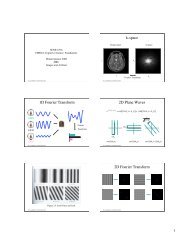Homework 6 - Center for Functional MRI
Homework 6 - Center for Functional MRI
Homework 6 - Center for Functional MRI
Create successful ePaper yourself
Turn your PDF publications into a flip-book with our unique Google optimized e-Paper software.
BENG280A, Principles of Biomedical Imaging 11/08/10<br />
Fall Quarter 2010<br />
Readings:<br />
Read Chapters 6 and 7 in Nishimura<br />
HOMEWORK #6<br />
Due in Class on Thursday 11/18/10<br />
Problems: (In Nishimura unless otherwise stated)<br />
1. Problem 5.1<br />
2. Problem 13.11 in Prince and Links.<br />
3. Problem 5.6.<br />
4. Consider the gradient wave<strong>for</strong>ms shown in the figure on the next page. The full<br />
wave<strong>for</strong>ms are shown in panels (a) and (b), and zoomed-in views are shown in (c) and<br />
(d). The analog-to-digital converter (ADC) is turned on during the flat parts of the readout<br />
(Gx) gradients with a sampling rate of "t .<br />
(a) Determine the sequence parameters (G1, G2 and G3, and "t ) to achieve the<br />
following image specifications: FOV x = 192mm; FOV y = 192 mm, ! x<br />
= 3 mm and<br />
" y<br />
= 24 mm.<br />
!<br />
(b) Draw the k-space trajectory (make sure to label units ! correctly).<br />
!<br />
5. MATLAB exercise. In this exercise you will generate figures similar to those in Figure<br />
! 5.7. Consider a uni<strong>for</strong>m object with FOV x = 4cm; and FOV y = 2cm. The desired<br />
resolution is 0.5cm in both the x and y directions. Define a grid <strong>for</strong> the simulation of the<br />
<strong>for</strong>m [x,y]=meshgrid([-2:dx:2],[-1:dx:1]);dx = .1. Use the quiver command in MATLAB to<br />
plot out the relative phases of the spins <strong>for</strong> k x ranging from "W kx<br />
2 to W kx<br />
2 in steps of<br />
"k x<br />
. You may assume that k y<br />
= 0 <strong>for</strong> your simulations. Verify that the periods of<br />
spatial variation of the spin phases are what you expect. Also, comment on the<br />
differences in spatial variation between the negative and positive frequencies. Hint:<br />
Define a complex exponential and then use the real ! and imaginary ! parts as inputs into<br />
the quiver command. ! You may also want to play around with the scaling parameter in<br />
the quiver function to adjust the length of the arrows.
(a) Gx gradient<br />
G1<br />
0<br />
-G1<br />
(b) Gy gradient<br />
G2<br />
0<br />
-G3<br />
(c) Gx gradient (Zoomed in)<br />
G1<br />
0<br />
T/2 = 320 usec<br />
T = 640 usec<br />
-G1<br />
(d) Gy gradient (Zoomed in)<br />
G2<br />
! = 10 usec<br />
0<br />
-G3



